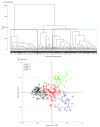Development of a New Classification System for Idiopathic Inflammatory Myopathies Based on Clinical Manifestations and Myositis-Specific Autoantibodies
- PMID: 30208379
- PMCID: PMC6583199
- DOI: 10.1001/jamaneurol.2018.2598
Development of a New Classification System for Idiopathic Inflammatory Myopathies Based on Clinical Manifestations and Myositis-Specific Autoantibodies
Abstract
Importance: Idiopathic inflammatory myopathies are heterogeneous in their pathophysiologic features and prognosis. The emergence of myositis-specific autoantibodies suggests that subgroups of patients exist.
Objective: To develop a new classification scheme for idiopathic inflammatory myopathies based on phenotypic, biological, and immunologic criteria.
Design, setting, and participants: An observational, retrospective cohort study was performed using a database of the French myositis network. Patients identified from referral centers for neuromuscular diseases were included from January 1, 2003, to February 1, 2016. Of 445 initial patients, 185 patients were excluded and 260 adult patients with myositis who had complete data and defined historical classifications for polymyositis, dermatomyositis, and inclusion body myositis were enrolled. All patients were tested for anti-histidyl-ARN-t- synthetase (Jo1), anti-threonine-ARN-t-synthetase (PL7), anti-alanine-ARN-t-synthetase (PL12), anti-complex nucleosome remodeling histone deacetylase (Mi2), anti-Ku, anti-polymyositis/systemic scleroderma (PMScl), anti-topoisomerase 1 (Scl70), and anti-signal recognition particle (SRP) antibodies. A total of 708 variables were collected per patient (eg, cancer, lung involvement, and myositis-specific antibodies).
Main outcomes and measures: Unsupervised multiple correspondence analysis and hierarchical clustering analysis to aggregate patients in subgroups.
Results: Among 260 participants (163 [62.7%] women; mean age, 59.7 years; median age [range], 61.5 years [48-71 years]), 4 clusters of patients emerged. Cluster 1 (n = 77) included patients who were male, white, and older than 60 years and had finger flexor and quadriceps weakness and findings of vacuolated fibers and mitochondrial abnormalities. Cluster 1 regrouped patients who had inclusion body myositis (72 of 77 patients [93.5%]; 95% CI, 85.5%-97.8%; P < .001). Cluster 2 (n = 91) regrouped patients who were women and had high creatine phosphokinase levels, necrosis without inflammation, and anti-SRP or anti-3-hydroxy-3-methylglutaryl-coenzyme A reductase (HMGCR) antibodies corresponding to immune-mediated necrotizing myopathy (53 of 91 [58.2%]; 95% CI, 47.4%-68.5%; P < .001). Cluster 3 (n = 52) regrouped patients who had dermatomyositis rash and anti-Mi2, anti-melanoma differentiation-associated protein 5 (MDA5), or anti-transcription intermediary factor-1γ (TIF1γ) antibodies, mainly corresponding with patients who had dermatomyositis (43 of 52 [82.7%]; 95% CI, 69.7%-91.8%; P < .001). Cluster 4 (n = 40) was defined by the presence of anti-Jo1 or anti-PL7 antibodies corresponding to antisynthetase syndrome (36 of 40 [90.0%]; 95% CI, 76.3%-97.2%; P < .001). The classification of an independent cohort (n = 50) confirmed the 4 clusters (Cohen κ light, 0.8; 95% CI, 0.6-0.9).
Conclusions and relevance: These findings suggest a classification of idiopathic inflammatory myopathies with 4 subgroups: dermatomyositis, inclusion body myositis, immune-mediated necrotizing myopathy, and antisynthetase syndrome. This classification system suggests that a targeted clinical-serologic approach for identifying idiopathic inflammatory myopathies may be warranted.
Conflict of interest statement
Figures


Comment in
-
Autoantibodies at the Center of (sub)Classification-Issues of Detection-Reply.JAMA Neurol. 2019 Jul 1;76(7):868-869. doi: 10.1001/jamaneurol.2019.0443. JAMA Neurol. 2019. PMID: 30933238 No abstract available.
-
Autoantibodies at the Center of (sub)Classification-Issues of Detection.JAMA Neurol. 2019 Jul 1;76(7):867-868. doi: 10.1001/jamaneurol.2019.0440. JAMA Neurol. 2019. PMID: 30933251 No abstract available.
References
Publication types
MeSH terms
Substances
Supplementary concepts
LinkOut - more resources
Full Text Sources
Other Literature Sources
Medical

